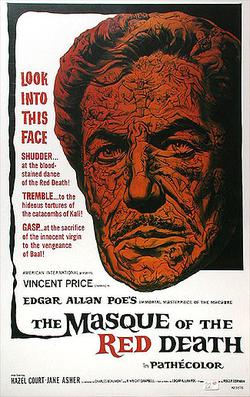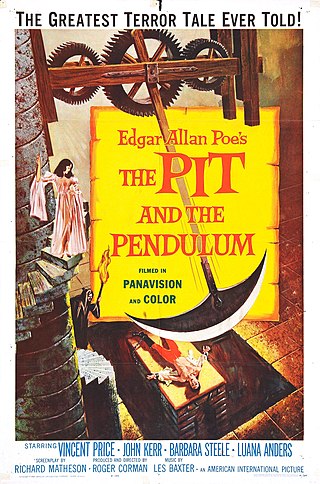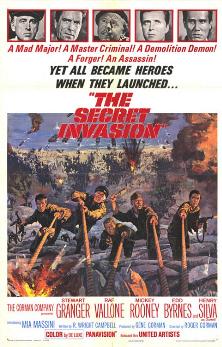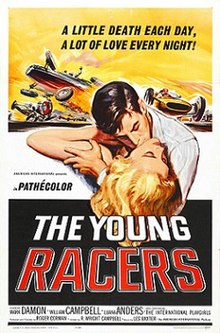
Roger William Corman is an American film director, producer, and actor. Known under various monikers such as "The Pope of Pop Cinema", "The Spiritual Godfather of the New Hollywood", and “The King of Cult”, he is known as a trailblazer in the world of independent film. Many of Corman's films are based on works that have an already-established critical reputation, such as his cycle of low-budget cult films adapted from the tales of Edgar Allan Poe.

The Fast and the Furious is a 1954 American crime drama B movie from a story written by Roger Corman and screenplay by Jean Howell and Jerome Odlum. The film stars John Ireland and Dorothy Malone. Ireland also served as the film's co-director.

William Campbell was an American actor who appeared in supporting roles in major film productions, and also starred in several low-budget B-movies and horror films.

Blood Bath is a 1966 American horror film directed by Jack Hill and Stephanie Rothman and starring William Campbell, Linda Saunders, Marissa Mathes, and Sid Haig. The film concerns a mad painter of weird art who turns into a vampire-like man by night, apparently as a result of a family curse, and believes that he has found his reincarnated mistress in the person of an avant-garde ballerina.

Dementia 13, known in the United Kingdom as The Haunted and the Hunted, is a 1963 independently made black-and-white horror-thriller film, written and directed by Francis Ford Coppola and produced by Roger Corman. It was Coppola's feature film directorial debut. The film stars William Campbell and Luana Anders with Bart Patton, Mary Mitchell, and Patrick Magee. It was released in the United States by American International Pictures during the fall of 1963 as the bottom half of a double feature with Corman's X: The Man with the X-ray Eyes.

The Masque of the Red Death is a 1964 horror film directed by Roger Corman and starring Vincent Price. The story follows a prince who terrorizes a plague-ridden peasantry while merrymaking in a lonely castle with his jaded courtiers. The screenplay, written by Charles Beaumont and R. Wright Campbell, was based upon the 1842 short story of the same name by American author Edgar Allan Poe, and incorporates a subplot based on another Poe tale, "Hop-Frog". Another subplot is drawn from Torture by Hope by Auguste Villiers de l'Isle-Adam.

The Pit and the Pendulum is a 1961 horror film directed by Roger Corman, starring Vincent Price, Barbara Steele, John Kerr, and Luana Anders. The screenplay by Richard Matheson was loosely inspired by Edgar Allan Poe's 1842 short story of the same name. Set in sixteenth-century Spain, the story is about a young Englishman who visits a forbidding castle to investigate his sister's mysterious death. After a series of horrific revelations, apparently ghostly appearances and violent deaths, the young man becomes strapped to the titular torture device by his lunatic brother-in-law during the film's climactic sequence.
"Life Is Just a Bowl of Cherries" is a popular song with music by Ray Henderson and lyrics by Lew Brown, published in 1931. Ethel Merman introduced this song in George White's Scandals of 1931. A Rudy Vallée version, recorded in 1931, spent five weeks in the top-10 pop music charts. The song was revived in 1953 by singer Jaye P. Morgan.

Charles Byron Griffith was an American screenwriter, actor and film director, son of Donna Dameral, radio star of Myrt and Marge, along with Charles' grandmother, Myrtle Vail, and was best known for writing Roger Corman productions such as A Bucket of Blood (1959), The Little Shop of Horrors (1960), and Death Race 2000 (1975).

The Premature Burial, also known as Premature Burial, is a 1962 American horror film directed by Roger Corman and starring Ray Milland, Hazel Court, Alan Napier, Heather Angel and Richard Ney. The screenplay by Charles Beaumont and Ray Russell is based upon the 1844 short story of the same name by Edgar Allan Poe. It was the third in the series of eight Poe-themed pictures, known informally as the "Poe Cycle", directed by Corman for American International Pictures.

The Secret Invasion is a 1964 American war film directed by Roger Corman. It stars Stewart Granger, Raf Vallone, Mickey Rooney, Edd Byrnes, Henry Silva, Mia Massini, and William Campbell. Appearing three years before The Dirty Dozen (1967), the film features a similar World War II mission where convicts are recruited by the Allies for an extremely hazardous operation behind enemy lines.

Rock All Night is a 1957 crime drama film produced and directed by Roger Corman. Distributed by American International Pictures, it is based on a 25-minute television episode of The Jane Wyman Show from 1955 called "The Little Guy." It stars Dick Miller, Russell Johnson and Abby Dalton. It co-stars Mel Welles, Ed Nelson and Clegg Hoyt. The film was released as a double feature with Dragstrip Girl.
Slightly Static is a 1935 American short comedy film directed by William H. Terhune. It was the debut film of Roy Rogers who performed with the Sons of the Pioneers although his name was uncredited. It is the 17th entry in the series.

Five Guns West is a 1955 Western film set during the American Civil War directed by Roger Corman. It was Corman's first film as director although he had already made two as producer. It was the second film released by the American Releasing Company, which later became American International Pictures.
Robert Wright Campbell, often credited as R. Wright Campbell or Robert Campbell, was an American screenwriter, author and occasional actor. He was the brother of actor William Campbell and brother in law of Judith Campbell Exner. He wrote ten television series, including Maverick and Marcus Welby, M.D..
Trailers from Hell is a web series in which filmmakers discuss and promote individual movies through commenting on their trailers. While the series emphasizes horror, science fiction, fantasy, cult, and exploitation cinema, films from a wide variety of genres have been covered. Trailers from Hell launched as a website in October 2007, as a collaborative project by film director Joe Dante, new media entrepreneur Jonas Hudson, graphic artist Charlie Largent, web developer Tom Edgar, and producer Elizabeth Stanley. It also premiered at SXSW in 2009.

The Wild Racers is a 1968 American film directed by Daniel Haller and starring Fabian, Mimsy Farmer, and Judy Cornwell. The screenplay concerns a Grand Prix racing car driver.

I Escaped from Devil's Island is a 1973 exploitation film about an escape attempt from Devil's Island. Roger Corman and Gene Corman produced this grim adventure saga which was made to cash in on the release of Papillon.

Raphaël Gesqua is a French composer, arranger and sound designer.
The Conquerors, historical television series looks at famous leaders, such as Cortés, Andrew Jackson and others, and shows how they rose to prominence and vanquished enemies in the field.















